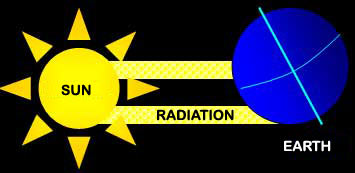|
|
1st PART
ATMOSPHERE AND ENERGYOur world gets its energy from a single source : the Sun. Soil, oceans and atmosphere receive energy from the sun in the form of electromagnetic radiation. The light we see is made of this radiation. The radiation which our eyes are sensitive represent to only a small portion of the radiation that we receive from the Sun.
Geographic
variability in the average
amount of solar radiation
reaching the Earth's
surface. The equator receives more energy than the poles because : Rays arrive directly at the equator (contrary to other regions where rays arrive obliquely) ; the Sun is a little closer to the equator than in other regions. The Earth receives energy from the sun but also loses some through radiation. Earth radiates energy, as our bodies do. In fact, every body which has a temperature above 0 Kelvin (-459,67°F and -273°C) emits radiation. In the case of the Earth and our bodies, this radiation is called « infrared radiation ». The sun is the larger source of energy the Earth receives. The solar constant is 1368 W/m2. So at the top of the atmosphere between the equator and the tropics it is 1368 W/m2,but the overall average energy received on Earth is : 1368/4 W/m2 or 342 W/m2.  The radiation
spread over a larger
area at high latitudes
(poles) Of these 342 W/m2 arriving at the top of the atmosphere, only a third of the energy reaches the atmosphere, soil or the oceans... 102.W/m2 is escaping into space so that 175.W/m2 reaches the surface of the Earth. 20 W/m2 energy is dispersed between the soil and the atmosphere that warm them. 80 W/m2 is dispersed to the evaporation of water as it consumes energy. Then when the water vapour condenses to liquid water (for clouds, rain ...) it releases energy heating the atmosphere. Earth radiates 415 W/m2 as an IR so more energy than it receives. This is due to the greenhouse effect. These are gases that allow light (short wave) coming from the Sun to the Earth that trap infrared radiation (long wave) between greenhouse gas emissions to the atmosphere and the Earth. For more information on these gases 395.W/m2 heat the atmosphere on these 415.W/m2 and 20.W/m2 escape into space. 340.W/m2 furnish the greenhouse effect, is a mechanism for reuse in a loop infrared radiation. 55 W/m2 are evacuated to space. What makes the Earth send as much energy back into space that it uses. On the 342.W/m2 light the atmosphere receives 102.W/m2 are lost so 240.W/m2 are retained. As the air removes the heat is received into space 65+20+80+20+55=240.W/m2. all is balanced.
A video : Earth's Energy Budget. The shortwave radiation and the atmosphereThe atmosphere is full screen gamma rays and X-rays. Their interaction with the upper atmosphere gives the ionosphere. Only part of the UV spectrum of visible light and radio waves reach the ground.
WARNING |



